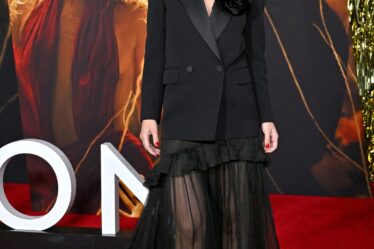
If you passed Andy Warhol on the street today, you’d instantly recognize him. The late artist’s white, bowl-cut wigs and extra-large specs were just as noticeable as his Pop art canvases. Yet he was a deliberately mysterious figure who rarely shared details of his personal life. “I just do art because I’m ugly and there’s nothing else for me to do,” Warhol would tell reporters. A new Netflix docuseries, The Andy Warhol Diaries (released today), aims to delve further into the influential artist’s mind.
Directed by Andrew Rossi and produced by Ryan Murphy, the new six-part series is based on the personal memoirs of Warhol that were posthumously published back in 1989. Through narration—using Warhol’s own words and voice, which was re-created with A.I. technology—the series aims to offer a better understanding of Warhol’s work and what the artist grappled with personally behind the scenes. Through the decades, especially at his height during the ’60s and ’70s, a clear theme emerges: that Warhol, a lover of all things fame and high society, used glamour in his work as a decoy.
Content
This content can also be viewed on the site it originates from.
Born in Pittsburgh to a devout Catholic mother, the new docuseries suggests that Warhol’s traditional upbringing caused him to bear a sense of shame around his queer identity. Having never had the opportunity to be a proudly out gay man, his work as an adult began reflecting the life he wanted to live. Celebrity, glitz, and excess were all things that he secretly desired for himself, as someone who often had to live in the shadows. As his artwork began to get noticed by critics and journalists, Warhol moved through New York’s upper echelon but remained in the closet. (At the time, it was still frowned upon, and often unsafe, to be LGBTQ+). “Everyone knows he’s gay, but he’s the right kind of gay—he’s not the out-in-the-streets kind of gay,” says artist Glenn Ligon in the series.
When he became famous, Warhol began using his fashion choices as a means of deflection and survival. “That idea of shame is very much part of Warhol’s personal narrative,” says Jessica Beck, curator of the Warhol Museum. “This idea of covering and transforming physically—he used it to shield himself from criticism.” Patrick Moore, the director of the Warhol Museum, adds, “For a gay guy, if you’re not going to be the stud, you might as well be the freak. Drag queens have taught us this for a long time: You’re not going to beat me up because I’m going to dress up.” He mostly wore sleek turtlenecks and sharp suits and ties, which the series alludes to as him attempting to pass for straight. But it was his cartoony wigs and glasses that served as his true armor.



